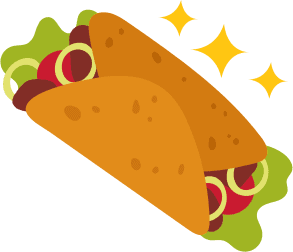The massively popular meal delivery service, HelloFresh, is known for its delicious, high-quality recipes and the convenience they add to people’s lives.
However, as more people turn to HelloFresh to make mealtime easier, questions have arisen about their nutritional value and overall healthiness.
In this article, we will take a research-backed look at HelloFresh and explore whether this meal kit service is truly a healthy option for those looking to eat well and maintain a balanced diet.
We will examine the ingredients used in HelloFresh recipes, assess the nutritional value of these meals, and consider any potential drawbacks or concerns.
So if you're curious about whether HelloFresh is a healthy choice for you, keep reading for our comprehensive analysis.
First, How Do Experts Define A Healthy Meal?
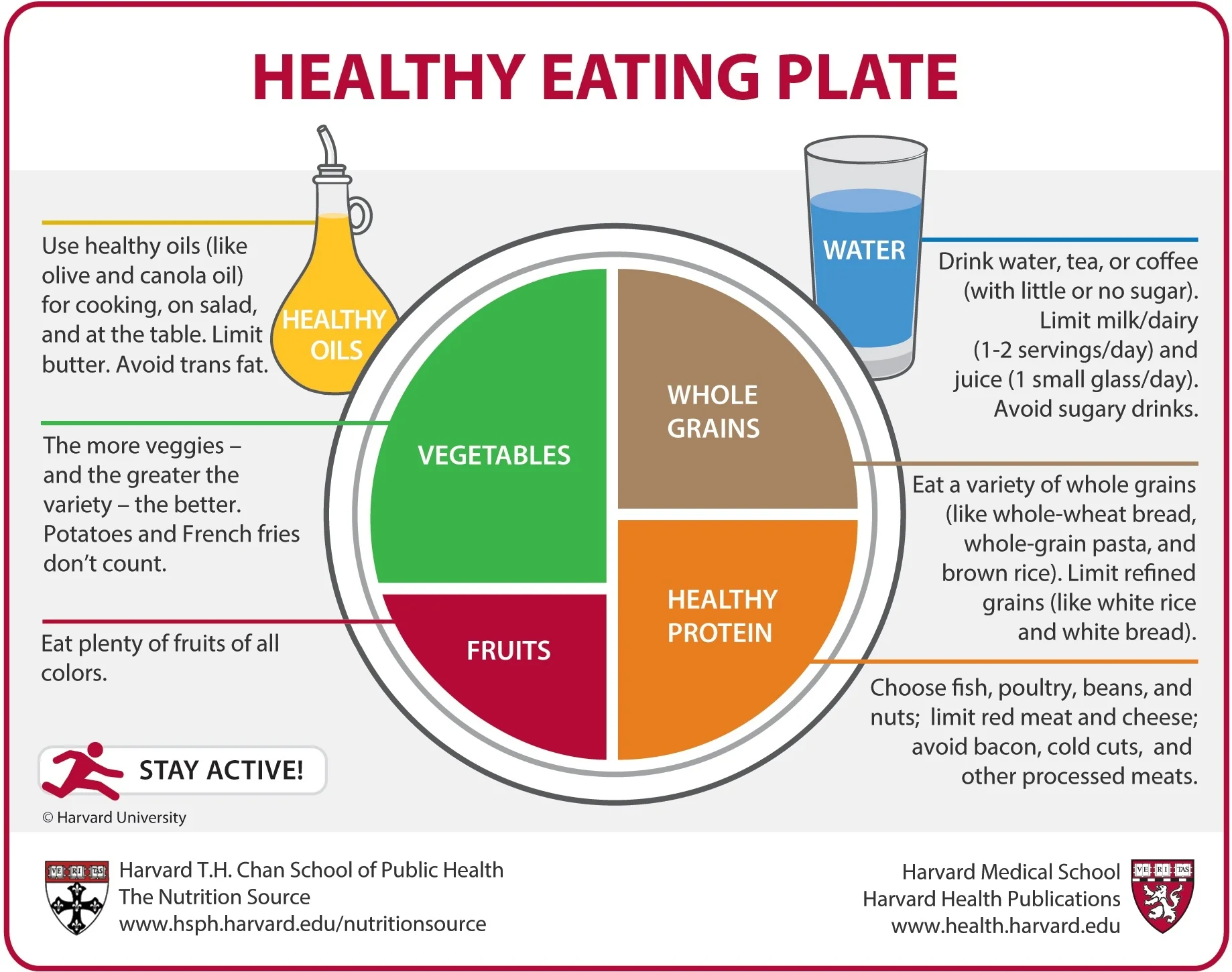
Harvard's nutrition experts developed the Healthy Eating Plate, which is a visual representation illustrating the recommended portions of essential food groups for a balanced and nutritious meal. As you can see in the image above, the plate includes vegetables, whole grains, fruits, healthy proteins, healthy oils, and water. Additionally, the plate features an image of an individual running with the phrase, "stay active!" as a reminder that a healthy diet is just as crucial as regular physical activity.
The Healthy Eating Plate recommends fruits and vegetables make up half of the plate. They advise including a variety of colorful fruits and vegetables. Interestingly, they don’t count potatoes as a vegetable because of their negative impact on blood sugar. However, UC Davis Health points out that even though potatoes are high in starch/calories, they are still a vegetable full of vitamins and minerals, including vitamin C, and are a good source of potassium and fiber.
Healthy protein includes poultry, fish, beans, and nuts. They recommend limiting red meat and avoiding processed meats such as sausage and bacon. After further researching “healthy protein” based on Harvard’s Healthy Eating Plate, I found this compelling statement:
“Available evidence indicates that it’s the source of protein (or, the protein “package”), rather than the amount of protein, that likely makes a difference for our health. [...] eating healthy protein sources like beans, nuts, fish, or poultry in place of red meat and processed meat can lower the risk of several diseases and premature death.”
If you are interested in learning more about the effect of red meat, I highly suggest reading this article that sources numerous studies on different diseases correlated with red meat intake.
Lastly, the Healthy Eating Plate recommends moderate amounts of healthy plant oils, including olive, canola, soy, corn, sunflower, peanut, and others. They highly suggest avoiding partially hydrogenated oils, which contain unhealthy trans fats, and limiting butter intake. The glass of water on the diagram serves as a reminder to drink water every day and to significantly reduce the consumption of sugary drinks.
The Harvard Healthy Eating Plate is just one example of how experts define health. However, I chose their recommendations over others because their method supports balanced, nutritious meals focused on healthy ingredients over calorie intake or weight loss.
Food Box HQ Note: I went with Harvard's Healthy Eating Plate is because it is based on the best available science and offers a more complete picture of basic nutrition advice than the USDA's MyPlate. The Healthy Eating Plate encourages the consumption of whole grains, healthy protein sources, an abundance of vegetables (excluding potatoes and French fries), a colorful variety of fruits, healthy oils, and water or other calorie-free beverages while limiting refined grains, red and processed meat, milk and dairy, juice, sugary drinks, and butter/trans fat. The Healthy Eating Plate also emphasizes the importance of staying active for weight control, which is not included in MyPlate.
HelloFresh Meal Plans: Are There Healthy Options?
Now that we have a grasp on what constitutes a healthy meal, let's take a closer look at the meal plans that HelloFresh provides.
The HelloFresh meal plans are customized based on the number of individuals eating (2 or 4) and the number of recipes you want delivered each week (2-6). You have the option to select from various preferences, such as Meat & Veggies, Veggie, Family-Friendly, Fit & Wholesome, Quick & Easy, and Pescatarian.
By choosing these categories, the weekly menu adjusts to display only meals based on your preferences, making it easier to navigate and find meals that you will enjoy. This ensures that you don't have to sift through menu options that do not fit your dietary requirements, such as meat and veggie meals if you're a vegetarian.
One would assume that the "Fit & Wholesome" preference would be more nutrient-balanced than other meal options... Right?
Unfortunately, HelloFresh's website does not offer many details about what each preference provides, so it's unclear what "Fit & Wholesome" entails. However, from my investigation, I discovered that the "Fit & Wholesome" meals aren't too distinct from the Meat and Veggies preference.
The Veggie options satisfy the Healthy Eating Plate criteria, as those meals are mostly made up of vegetables, grains, and healthy proteins like legumes. The Pescatarian meals also fit within the guidelines, as fish is a healthy protein source and contains Omega-3 fatty acids.
Nevertheless, HelloFresh displays all the meals on its weekly menu, and each meal includes the calorie count, allergen information, and a list of each ingredient/amount of ingredient.
Based on this information, it's evident that HelloFresh does not have a specific "healthy eating plan." Instead, it's up to the customer to choose balanced and nutritious meals from HelloFresh's weekly menu by reviewing the nutritional information for each meal individually. Fortunately, HelloFresh provides a wide selection of meals (20+ each week) with healthy proteins, vegetables, and grains.
Breakdown of HelloFresh Meals
To determine if HelloFresh meals qualify as “healthy” as defined by Harvard's Healthy Eating Plate, let's break down a few of their meals and compare them to the Healthy Eating Plate recommendations. From this comparison, we’ll be able to see the nutrient quality that these HelloFresh meals offer.
Chicken, Mushroom, & Chive Risotto with Garlic Herb Butter
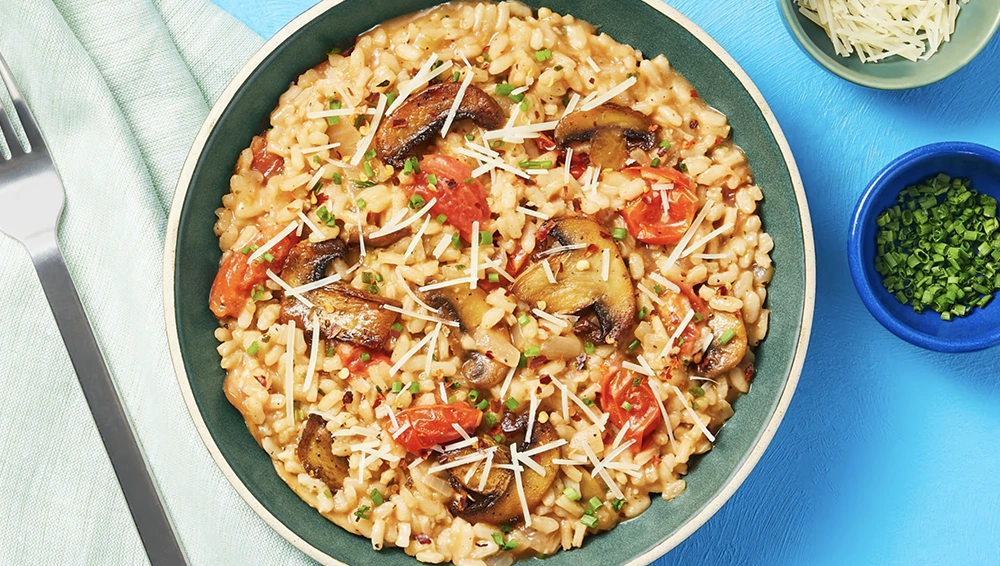
Ingredients (2 person serving):
- 1 unit Veggie Stock Concentrate
- 1 unit Yellow Onion
- ¾ cup Arborio Rice
- ¼ ounce chives
- 2 tbsp Parmesan Cheese
- 10 ounce Chicken breast Strips
- 4 ounce Button Mushrooms
- 1-clove Garlic
- 4-ounce grape tomatoes
- 2 tbsp garlic herb butter
- 1 tsp chili flakes
Nutritional Values (per serving):
- Calories: 780 kcal
- Fat: 30g
- Saturated Fat: 14g
- Carbohydrate: 81g
- Sugar: 8g
- Dietary Fiber: 2g
- Protein: 43g
- Cholesterol: 155mg
- Sodium: 720mg
It’s more challenging to compare a mixed dish to the Healthy Eating Plate, which is why I thought we should give it a try. Let’s break down each of the Healthy Eating Plate Recommended ingredients and compare them to this meal. The above serving size is for two people, so I’ll cut each amount in half as that is what each person would roughly receive on their plate.
Vegetables and fruits (½ plate): This meal calls for a whole yellow onion, a small amount of chives, 4 ounces of grape tomatoes, and 4 ounces of button mushrooms. That means one person would receive roughly half of those amounts on their plate. As the Healthy Eating Plate does not give recommended volume or calorie amounts, it is up to the person to build their own healthy eating plate with visual pointers. I would say that the amount of vegetables in this meal (along with the vegetable stock, which provides nutrients from vegetables) would make up roughly ¼ of the plate if we were to separate the ingredients.
As this meal does not include any fruit, it doesn’t quite make the recommended amount Healthy Eating Plate suggests for the intake of vegetables and fruits.
Whole grains (¼ plate): The only grain found in this recipe is Arborio rice, a short-grain white rice traditionally used in Risotto because it gives off a creamy texture as it cooks. Because white rice isn’t considered a whole grain, it doesn’t meet the recommendations set by The Healthy Eating Plate.
Protein (¼ plate): This recipe includes about 5 ounces of chicken per person, which would roughly make up about ¼ of the plate. Since chicken qualifies as a healthy protein, it meets the recommendations set forth by The Healthy Eating Plate.
Healthy Plant Oils (in moderation): When ordering this meal, they do not include the cooking oil; however, this recipe calls for 3 tsp of cooking oil and ½ tsp butter. Considering that these teaspoons are divided between the onions and mushrooms, and you have the choice to use a healthy plant oil on hand, I believe it falls under the “in moderation” recommendation. That said, this recipe also calls for 2 tbsp of garlic herb butter to be mixed in at the end for added flavor. Also, the ½ tsp butter is to be mixed with the rice.
Is the Chicken Mushroom Risotto Healthy?
This meal, although delicious, doesn’t quite meet the Healthy Eating Plate recommendations for a balanced, nutritious meal. However, several substitutions you could make would increase the nutrient quality of this meal.
Possible Substitutions
Since the Healthy Eating Plate suggests limiting the amount of butter one uses, you could easily skip the ½ tsp butter in the rice and add plant oil if you like. Even though the garlic herb butter would increase the flavor and texture of the rice, it isn’t necessary for this meal. The seasoning used in the butter (whatever that may be) could be added to the dish separately for added flavor, and you could skip the added butter altogether for a healthier meal.
As this meal could use more vegetables, you could easily incorporate a cup of steamed spinach or kale into the rice. I love adding steamed dark leafy greens to creamy rice/pasta dishes, as it’s a delicious and effortless way to consume more minerals/vitamin-dense vegetables.
To make this meal fully balanced and nutritious, the Whole Grains Council recommends substituting the arborio rice for short-grain brown rice or more colorful varieties such as Himalayan Red and Chinese Black.
Chimichurri Barramundi with Lemony Carrots & Garlic Couscous
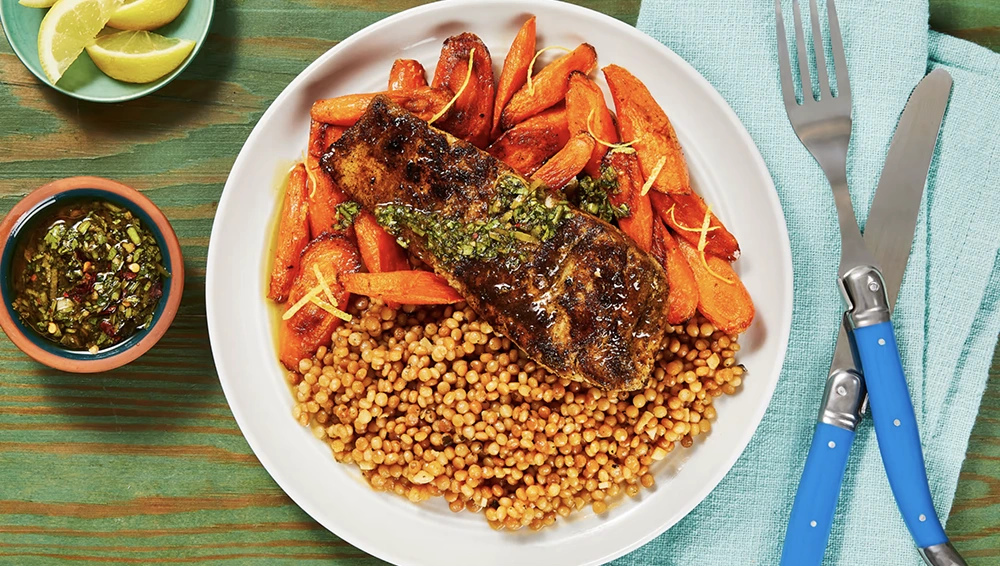
Ingredients (2 person serving):
- 12-ounce carrots
- 1 unit lemon
- 1 tsp cumin
- 5 ounce Israeli Couscous
- 10-ounce Barramundi
- ¼ ounce cilantro
- 2 clove garlic
- 1 tsp chili flakes
- 1 unit of vegetable stock
Nutritional Values (per serving):
- Calories: 620 kcal
- Fat: 31g
- Saturated Fat: 8g
- Carbohydrates: 54g
- Sugar: 12g
- Dietary Fiber: 7g
- Protein: 34g
- Cholesterol: 90mg
- Sodium: 360mg
Now, let’s break down each of these ingredients as a single serving and see how they compare to Harvard’s Healthy Eating Plate.
Vegetables and fruits (½ plate): The picture of this recipe on HelloFresh’s weekly menu shows roasted carrots on half of the plate, which makes figuring out the vegetable portion for this recipe easy. From that visualization, it’s clear that the amount of vegetables in this recipe meets the recommended Healthy Eating Plate amounts. Plus, lemon is included in this meal, including juice, wedges, and zest, which means this meal has a small portion of fruit.
Whole grains (¼ plate): This recipe calls for Israeli couscous, also known as pearl couscous. Israeli couscous is a type of pasta made from semolina flour: a refined flour made from durum wheat. Pearl couscous and regular couscous can be whole grains if they are made from whole wheat durum flour, but they are not considered whole grains if made from refined semolina flour. As this recipe uses Israeli couscous, which is most often made from refined semolina four and not whole durum wheat flour, let’s assume it is not a whole grain. In this way, it does not meet the Healthy Eating Plate recommendations for whole grains.
Protein (¼ plate): Barramundi, a type of fish, is the protein used in this dish. Also known as Asian sea bass, it is a very healthy fish as it is high in Omega-3 fatty acids and low in fat. In this way, Barramundi is most certainly a “healthy protein.”
Healthy Plant Oils (in moderation): This recipe calls for 2 tbsp and 2 tsp of cooking oil and 1 tbsp butter. These ingredients are not included in the delivery, so you have the choice to use the cooking oil you have on hand, which means you can use a healthy plant oil such as olive or sunflower oil for this recipe. The oil is divided among the roasted carrots, pan-cooked fish, and the chimichurri sauce (an oil-based topping). As the oil is divided and you can use a healthy plant oil, the amount of oil used in this recipe meets the Healthy Eating Plate recommendations.
Is the Chimichurri Barramundi Recipe Healthy?
As most of the ingredient portions meet the Healthy Eating Plate recommendations, this is a healthy meal. There is a generous amount of carrots, and the protein is very nutritious and low in saturated fats. The only thing this meal is lacking is a whole grain.
Possible Substitutions
You could easily make this dish healthier by substituting the regular pearl couscous for whole wheat couscous, much as you would substitute regular pasta for whole wheat pasta.
The 1 tbsp of butter in this recipe is used to lightly toast the couscous before it is cooked in the vegetable stock. You could easily substitute a healthy plant oil for the butter, which would make this meal even healthier and lower in saturated fats.
Steak with Burrata & Arugula Salad with Charred Peas, Lemony Panko & Steak Sauce with GREY POUPON® Dijon Mustard
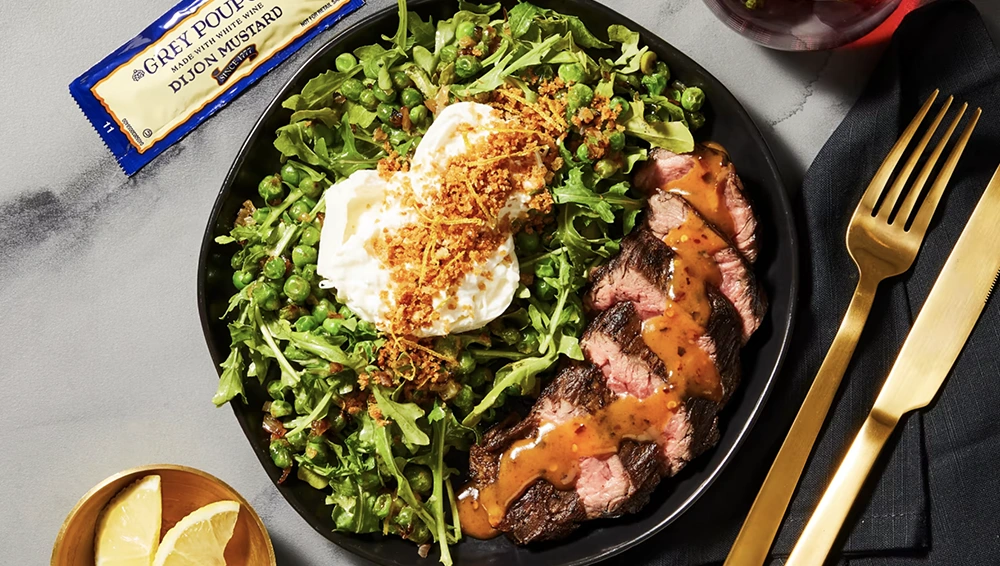
Ingredients (2 person serving):
- 1 unit shallot
- 1 unit lemon
- 4-ounce peas
- 1 tsp chili flakes
- 5 tsp rice wine vinegar
- 2 tbsp Crème Fraîche
- 4-ounce Burrata
- 2-cloves Garlic
- 10-ounce Bavette Steak
- ¼ cup Panko Breadcrumbs
- 1 unit peach jam
- 1 unit Grey Poupon Dijon Mustard
- 2-ounce Arugula Lettuce
Nutritional Values (per serving):
- Calories: 950 kcal
- Fat: 67g
- Saturated fat: 29g
- Carbohydrate: 44g
- Sugar: 20g
- Dietary Fiber: 7g
- Protein: 45g
- Cholesterol: 165mg
- Sodium: 880mg
Let’s see how this meal compares to Harvard’s Healthy Eating Plate.
Vegetables and Fruits (½ plate): Out of the several HelloFresh meals displayed on their weekly menu, I was attracted to this one because it appears that a pea/arugula salad covers more than half the plate. One of the best ways to eat a nutritious, balanced diet is to eat a variety of vegetables, especially leafy green vegetables. So far, this is one of the very few meal options where I found leafy greens as part of the dish. Plus, a lemon is used in this recipe, which contributes to fruit intake.
Whole grains (¼ plate): The only grain in this recipe is panko breadcrumbs, which is not a whole grain.
Protein (¼ plate): The protein in this meal is juicy bavette steak, about 5 ounces per person. The Harvard Healthy Eating Plate suggests limiting red meat. So, if this is your first or second serving of red meat for the week, then it would fit well into a healthy and balanced diet.
Healthy Plant Oils (in moderation): This is the only meal that hasn’t called for butter that I’ve found so far. Like the other recipes, it calls for 2 tbsp and 1 tsp of whatever cooking oil you have on hand. If using a healthy plant oil, you are creating a balanced meal as recommended by the Healthy Eating Plate.
Dairy: The Healthy Eating Plate doesn’t share how much dairy should make up the plate but suggests limiting dairy intake to one to two servings per day. This meal features burrata (a creamy mozzarella cheese) and Crème Fraîche. If this meal made up the majority of dairy you had for the day, then you would be keeping to the recommended daily dairy amounts suggested by The Healthy Eating Plate.
Is The Steak with Burrata & Arugula Salad Healthy?
Because every ingredient portion in this meal falls within the Healthy Eating Plate guidelines, except perhaps for the Panko breadcrumbs, this meal is certainly healthy. The balance of vegetables, protein, and healthy fat, contributes to a healthy, nutritious diet.
Possible Substitutions
Instead of using regular Panko breadcrumbs for this meal, you could use whole wheat breadcrumbs as a substitute. However, that still wouldn’t be enough whole grains to fill ¼ of your plate. I recommend cooking ½ to ¾ cup organic quinoa, a nutritious whole grain, that you could easily mix with the arugula/pea salad. Furthermore, with the addition of quinoa, you could eat less of the steak, as quinoa is a complete plant protein. Eating less steak means you consume less red meat, which can contribute to high cholesterol, high blood pressure, and heart disease if consumed too frequently and in high amounts as part of the daily diet.
However, whether or not you add quinoa or skip the breadcrumbs, this is one the healthiest and nutritionally balanced meals I’ve found on HelloFresh.
Final Thoughts: How Healthy is HelloFresh?
The core message of Harvard's Healthy Eating Plate is to eat a balanced and nutritious diet with a variety of vegetables, whole grains, healthy fats, and lean protein.
HelloFresh does a good job of crafting nutritionally balanced meals, as they always aim to provide a good portion of vegetables and healthy protein in their recipes.
That said, their meals could be healthier, more balanced, and more nutritious with certain ingredient substitutions. If they added more dark leafy greens to their meals, there would be more vegetable variety among their weekly menu options. As most of the wheat/grain in their recipes is processed wheat or grains, they could substantially increase a meal's nutrient quality by switching to whole wheat and grain products. Plus, I noticed that the majority of their recipes call for butter, which can be substituted for healthy plant oils. Butter, in moderation, can contribute to a healthy diet. However, using butter in every meal as cooking oil can add unnecessary amounts of saturated fat to the diet.
From reviewing a variety of HelloFresh meals, it appears they aim to provide delicious and swoon-worthy meals. They aim to provide balance and nutrition to their recipes, but their main goal isn’t to offer the healthiest meals on the market - their goal is to provide the tastiest.
In comparison to fast food, take-out, and processed foods, HelloFresh is a MUCH healthier alternative. Using their service can be a great way to start eating healthier and learning to make more balanced and nutritious meals from scratch. However, if you’re looking for a service that provides the healthiest and most nutritious meals, then HelloFresh probably isn’t for you.
To sum it up: HelloFresh is healthy but not the healthiest.
If you're looking for more healthy meal delivery services, you can view our favorites here.


